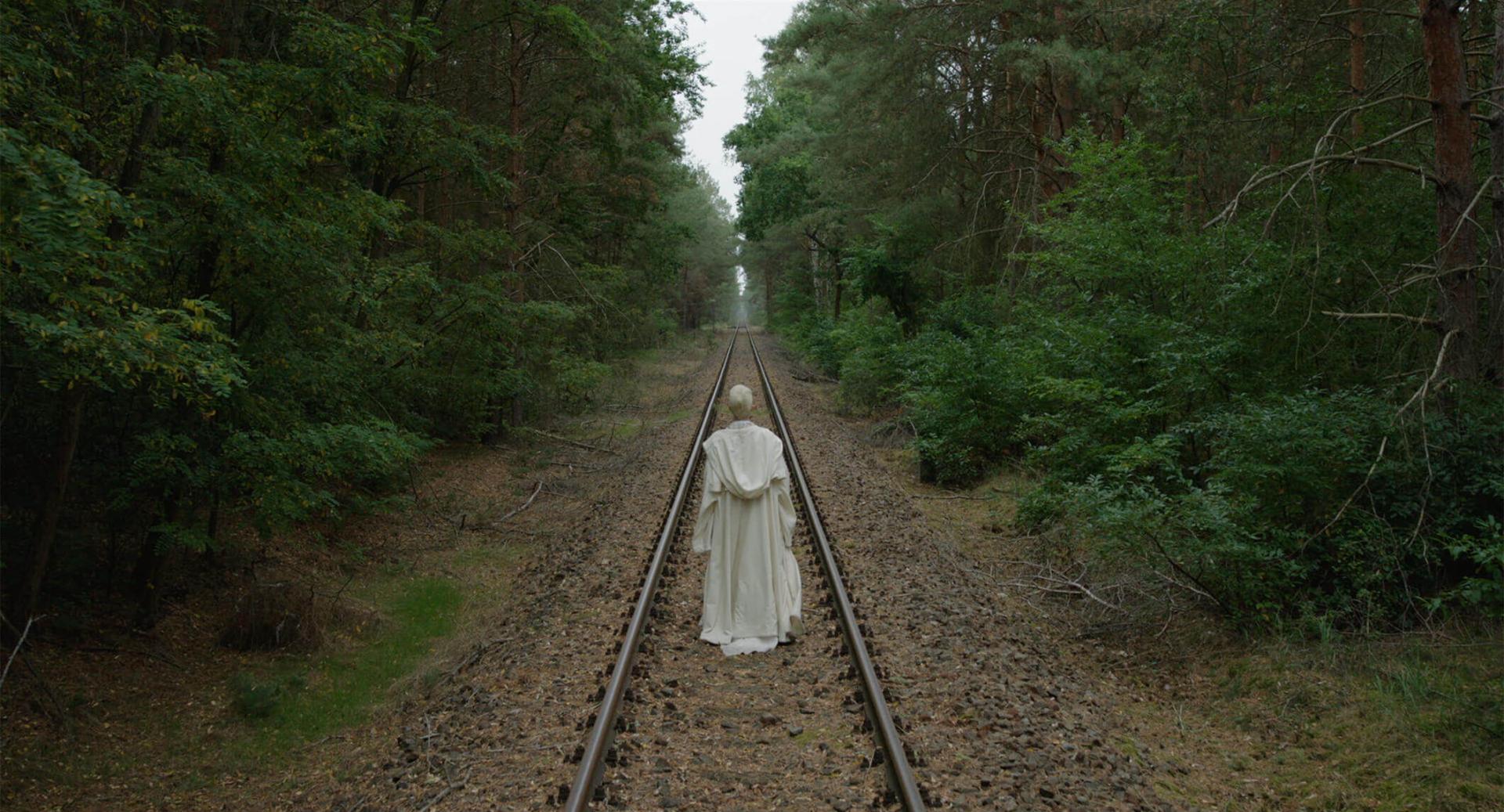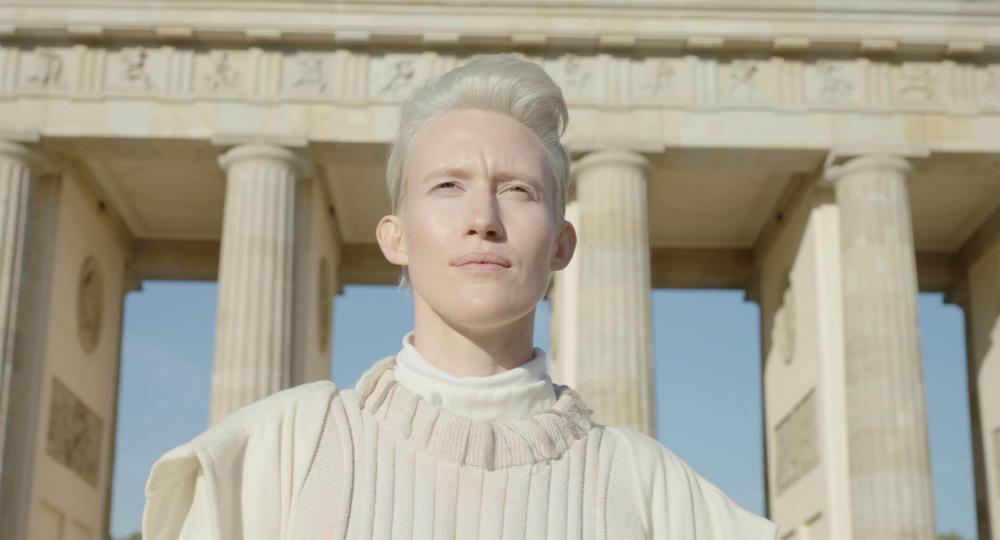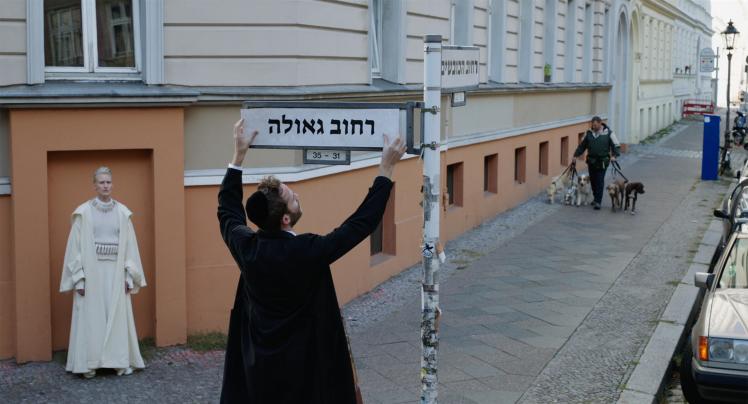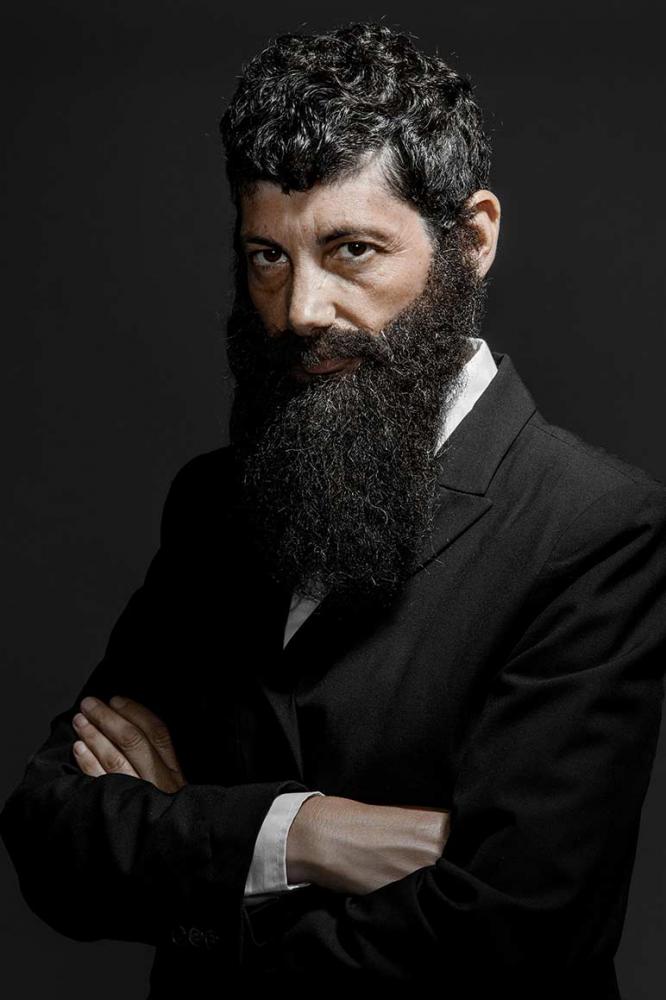Who is Malka Germania?
Yael Bartana in Conversation with Shelley Harten and Gregor H. Lersch

In 2021, the exhibition Yael Bartana – Redemption Now will be on display at the Jewish Museum Berlin. The centerpiece of the exhibition is the three channel video and sound installation Malka Germania. The genesis of this commissioned work, the issues it deals with, and the figure of Malka Germania form the starting point of the following conversation which was held by Shelley Harten and Gregor H. Lersch, the two curators of the exhibition, and the artist Yael Bartana.
She is hope, she is the leader, she is the Messiah, she is fake, she is history. She is the hero of your latest work of art. Who is Malka Germania?
To be honest, I am still trying to find out who she is. Or maybe I should say, who they are, as she embodies a plural, rather than a singular person.
It was 2017 when we contacted you to talk about the possibility of a large show of your works at the Jewish Museum Berlin, so our conversation has been going on for some years now. From the very start, however, you proposed developing a new project in and with the Museum, incorporating the institution as a place of German-Jewish history and culture into your artistic process. What piqued your interest?
 X
X
Yael Bartana, Malka Germania (film still), 2021, three channel video and sound installation, 43 min; commissioned by the Jewish Museum Berlin
I cannot pin that down to one thing, but it has a lot to do with the idea of identity. Many Israelis will tell you that they first felt Jewish by not living in Israel: The moment you live in Europe, “the diaspora”, you suddenly become a Jew. I, for one, never felt Jewish before. I was raised in a secular, patriotic, labor movement and militant atmosphere. I was educated to love the land of Israel, the nature, the history, the culture. Only after leaving Israel and wondering from a distance about my biography, did I ask myself “What is this place I grew up in?” Later, I realized that Zionism had succeeded in cutting the string between “the diaspora” and Israel. So, growing up in Israel in a secular family we never experienced that “Jewishness”, we were Israeli. And as for many Israelis of my generation and background, there was so much discomfort with Jewish identity. To me this is intriguing. For example, I felt somehow uncomfortable presenting my early works at the Jewish Museum in Amsterdam.
As an artist you don’t want to be recognized solely for an identity. I want to see identity in general as a starting point for a discussion of universal issues. I wouldn’t want my work to be read through the prism of Jewishness. That’s why I was very hesitant to have this large scale exhibition in Germany at the Jewish Museum.
What is Zionism?
Zionism, a Jewish movement that emerged in the late 19th century and promoted the settlement of Jews in Palestine and the establishment of a Jewish national homeland
What is Diaspora?
Diaspora (Greek for scattering), life outside of Palestine, Jewish exile began with the deportation of Jews to Babylon in 722 BCE
While talking about these questions it became clear that our mutual goal was an exhibition that took these questions of identity and historical narrative as the basis for relatable and universal issues. This way the Museum would be the host, but also part of an artistic adventure. So many ideas erupted out of our discussions, from staging a court of law in the Museum to incorporating the Museum’s archive in your artwork. Can you recall a starting point when Redemption Now and the figure of Malka Germania took off?
I only remember that I had a dream. In my dream, Prenzlauer Berg, the neighborhood where I stay when I’m in Berlin, was full of signs in Hebrew. All the street and shop signs had been replaced. So after this dream my first idea was to make a film where we just replaced German signs with Hebrew signs. This was the first scene I had in mind. I can’t decide if this dream was a nightmare or a longing for familiarity.

Yael Bartana, Malka Germania (film still), 2021, three channel video and sound installation, 43 min; commissioned by the Jewish Museum Berlin
So the greater theme, the grand epos of collective redemption, has a very personal and emotional starting point ...
Yes, in the almost ten years that I have lived in Germany, I went through very different and extreme, sometimes quite violent emotions, ranging from a lot of anger to feeling very comfortable, to being scared. And I never know whether they have anything to do with the fact that I betrayed my father (ז“ל) because he had told me to never stand on German soil.
And yet today, when you are not in Amsterdam, you live in Berlin.
Despite my father’s request. I decided to visit Berlin back in 2000; I wasn’t feeling so heavy but rather excited about the city then. The heaviness started when I came to stay here longer. There is always some sort of disturbing current. But in fact, I’ve never really arrived here. When my son Emil was born in 2011, I was here for a few months and then I continued being a visitor. I was always coming and going, never really landing, while at the same time really experiencing German culture through my East German family. I go to family events, where all is in German and I don’t understand anything. Hardly anyone speaks English. I keep on being the outsider raising a German kid in a German culture. I think it is right for me to keep this position of being an outsider.
The status of an outsider or onlooker fits well into the anthropological method of participative observer. Especially in your earlier works that rely on a more documentary style than the recent staged productions, observation seems key to both their production and understanding. You once described yourself as an “amateur anthropologist,” a term you adopted from Eva Hoffmann.
Exactly. I observe – I have always been an observer, never much of a talker.
That sounds a bit lonely, and yet you communicate a lot with the people at the places you visit …
In my early works I was indeed solitary, observing self-made social rituals – pointing my camera at events conducted by the state like in the film Trembling Time where I filmed the two minutes of silence on the evening of the Soldiers’ Memorial Day or pointing my camera at the SUV’s in Kings of the Hill. But once projects expanded, and production became extensive and long term, I started to work in collaboration with activists, professional film crews and at times with scholars who want to escape their traditional academic life and be part of an art project, having their knowledge incorporated in a more fantastical moment.
In Berlin, observation means that I am going back and forth in sincere dialogue with the city and its people and culture.
Do you have the impression that people, especially here in Berlin, are looking for redemption, dreaming of redemption, are in need of redemption?
Yes, I always felt Germans and Jews needed redemption from history somehow. But is it possible to be redeemed? What does redemption look like? What is the image of redemption? Historically the redeemer is an outsider within his own culture, with a strong need to change things.
As an observer of collective identity structures, German efforts of “Vergangenheitsbewältigung,” of coming to terms with its past, must be fascinating to watch.
It’s interesting to see that each time I show footage from the production, German people say they feel redeemed already only from looking at the material. Because I’m not German, I don’t know what it means when people say that – maybe you can guess?
It often seems difficult to find the right words to talk about our shared history and its meaning today, and for very good reasons. Your images – even in their unedited form – give a language to this emotional German-Jewish-Israeli triangle and they release something. Redemption in the end is some kind of release. It’s a way to let go of something, even just for an elusive moment, though it never really leaves you. Possibly that’s the reason why people react to your works in this way.
I’m only guessing the issue is that everybody was so traumatized after two World Wars, followed by the division of the country and the insanity of the Stasi scenario. Everything happened in a very short time. I cannot breathe even thinking about it. I understand the impulse to push all this away and to repress all emotions attached to the events. I’m not a psychologist, so I lack the skills to decipher the trauma. But I ask: What’s this sticky energy?
How does this discomfort translate into your work?
I would say in the way ambiguities come to the surface. In the beginning of the project, I had just come back to Berlin from New York and was completely jetlagged and so awake I couldn’t fall asleep. So, in one night, I wrote ten scenes, a decalogue, of what I wanted to make for the Jewish Museum. I wrote all the scenarios without really stopping myself and being too critical. Even with things that did not really make sense. I incorporated some of the scenes in the film, such as the rise of Albert Speer’s Germania model out of the Wannsee. Other scenes, I left out.
The lyricist and writer Max Czollek has called out for Jews and other minorities in Germany to de-integrate: German Jews should stop participating in what Michal Bodemann coined as “representationism”, a “Gedächtnistheater” (theater of memory), in which German Jews are given a designated role in the way the non-Jewish majority forms their collective identity. Your work has been criticized in the past for not following the rules of commemoration and at times even of being disrespectful towards the victims of the Holocaust. Do you anticipate the same criticism for Malka Germania?
I think, like any of my works, some will love the work, and some will hate it. Maybe 50-50. But most people definitely won’t stay indifferent. And it is this provocation of thought, the self-questioning and the political agency resulting out of it which seems most important to me – more so than if everyone is pleased with what they see.
German Jews certainly carry different Jewish experiences compared to mine, different burdens and traumata. I totally get what Czollek suggests, and I believe in the idea of de-integration and radical plurality.
I feel there is a need for transformation in Germany, a new vision for all the different minorities, including the Israelis living here. But at the same time, things are pretty good here. There are not so many worries, no having to fight, no being in constant conflict. Maybe Malka Germania is the accumulation of being foreign to the place and wanting to be part of it? But I also ask myself whether this would really be a fulfilment or rather some sort of a nightmare. That’s why my redemption fantasy expands to the question of what Germany can do in the Israeli-Palestinian conflict – for me a resolution would be some kind of redemption.
This tension of utopia and dystopia, dreams and nightmares, is almost always part of your larger, staged projects.
Obviously I am very attracted to utopia, because it offers possibilities.
…and hope.
Yes and hope. I remember working on the film trilogy ... and Europe will be stunned. In Poland I invited a lot of people to join the movement in a real, but also in a fictional way. Most of them came from the queer community, from alternative or minority groups. They really wanted to take part in the project. For these people it created a space for the hope that Poland will be different – in a real way. What the participants were experiencing in the work of art may not have been utopia, but a moment of change. Also, the Israelis coming to Poland for the first time, building a Kibbutz in the middle of Warsaw, precisely in the former Jewish Ghetto where the Museum for the Polish Jews stands now – they would never have considered going to Poland otherwise. Especially at the time, for many Israelis Poland was supposed to remain the enemy to the Jews, which, for example, means that no contact with Polish people was encouraged during school trips to Poland. But this was an art project – almost like a fun summer camp. And then, coming into contact with the Polish people a real discourse, a real exchange began. For me that’s actually more important than the final result of the work itself.
In the Jewish Renaissance Movement the utopia was embodied by a variation of the Zionist dream – a political movement. In Malka Germania, hope is personified by the Messiah, arriving in Berlin.
The hope for redemption can be attached to religious as well as to political leaders. I have a problem with messianism in all its forms, especially when political and religious messianism is institutionalized and aligns with fanaticism. It makes me quite sad that religion is so overtaken by a lot of political ideology – something feels very poisoned, when that’s the case.
Who is Malka in this constellation of religious and political sentiments?
It’s a problem to declare Malka the Messiah, because with a Messiah you always have followers who will call her holy and antagonists who will call her a whore.
Aren’t the followers or adversaries of Malka Germania the viewers of the film? They have to decide if they are being convinced by her epiphany or not. Here, Malka Germania follows a pattern that can be found in most of your works: They call for audience participation, thus engaging the viewers into action in one way or another.
Indeed. This way Malka remains quite obscure – as her identity is being constructed by the audience and is not dictated by the film.
The identity of Malka seems very fluid.
Yes, she’s identity fluid and gender fluid. It definitely shows in her stunning, androgynous look. She is not what I imagine people expect a Messiah to look like. I’m very much interested in post gender and its opening up of possibilities. I explore it in other works as well, such as Herzl, Inferno or Simone the Hermetic.
You have actually put yourself in the position of a leader in your self-portrait as Theodor Herzl.
No, that’s Theodor Herzl being Yael!
Apart from your longstanding interest in Theodor Herzl, there is a continuation of leadership figures in your work: Slawomir Sierakowsky is the leader of the Jewish Renaissance Movement but also a real-life activist, the high priest in Inferno, Simone the Hermetic and the question of female leadership in What If Women Ruled the World, the same female leader appearing as the president in Two Minutes to Midnight and as The Undertaker. What is your fascination with or understanding of leadership? Are you the leader?
I always feel uncomfortable in the role of a leader, standing on a square giving a speech. I don’t have it in me. But leadership can come in different forms. All artists are sort of leaders, aren’t they? At least visionaries. We should ask whether Herzl was a successful artist.
Leadership is dangerous – it can go very wrong very quickly.
That’s the trouble with POWER. Leaders disappoint us very quickly.
This is why I am so careful with Malka. And this was one of the reasons I wanted to eliminate the leader of the Jewish Renaissance Movement. I felt if he had too much power he would mess up. The power has to stay with the people. I am currently following Belarus’ attempts to dethrone the dictator closely … But I am very attracted towards and have a lot of admiration for people who are leading in a good way. And I think we do need visionaries – leaders who are protecting society. I even think I would like to initiate an artist leadership camp.
 X
X
Yael Bartana, Herzl I, 2015, photograph series of 6 images total, color photograph, fine art print, 60 × 40 cm; Yael Bartana
So the person Herzl and you represent in the photograph empowers, enables and opens a space for the imagination?
Yes, in this sense I think for me the artwork is the redemption more than anything else. The images are the redemption. It is the accumulation of images that create associations with certain histories, as well as the present, or future possibilities, more than being the thing itself. I didn’t follow so much the logic of the Messiah in a very direct way, one of epiphany and salvation, but Malka’s appearance does trigger a discussion around history, redemption and the person delivering it. You could say, Malka is my alter-ego.
Malka appears in very iconic places in Berlin. But what place – real or imagined – does she come from or go to? You leave this open in the film. What is that space for you?
For me it’s the “no-space”. The journey. She comes from nowhere. She goes to nowhere. It’s undefined. Berlin is only one station.
Another key figure of the video is the camel, which seems to pass this station, set in Berlin, leading people away.
If I look at the camel, I feel he’s my redemption.
The camel is an allegory of nomadism. If you feel the camel is redemption, is he opening up an alternative to belonging somewhere?
That goes back to my interest in nationalism and other creations of control that have been invented in modern history and could be redefined or cast aside for new social and political constellations that we have yet to imagine. I have always felt more comfortable being in between. For the past twenty years I have mostly been traveling and been to so many places, always seeking ways to feel at home but keeping my position as an outsider, as an observer.
Yael Bartana. The Book of Malka Germania was compiled for the exhibition Yael Bartana – Redemption Now. This interview was first published there. We would like to thank Dr. Cantz'sche Verlagsgesellschaft mbH & Co. KG for their kind permission to publish it on the website of the Jewish Museum Berlin.
Citation recommendation:
Shelley Harten, Gregor H. Lersch (2021), Who is Malka Germania?. Yael Bartana in Conversation with Shelley Harten and Gregor H. Lersch.
URL: www.jmberlin.de/en/node/7893

Exhibition Yael Bartana – Redemption Now: Features & Programs
- Exhibition Webpage
- Yael Bartana – Redemption Now: 4 Jun to 21 Nov 2021
- Publications
- Yael Bartana. The Book of Malka Germania: English edition, 2021, with reading sample for download
- Yael Bartana. Das Buch der Malka Germania: German edition, 2021, with reading sample for download
- Digital Content
- Exhibition opening: Video, 2021
- Podcast series Malka, Who?: Four episodes, 2021, in English and German
- Current page: Who is Malka Germania? Yael Bartana in conversation with Shelley Harten and Gregor H. Lersch, 2021
- Artist Talk with Yael Bartana: Video recording, 2021
- See also
- Yael Bartana, Artist



